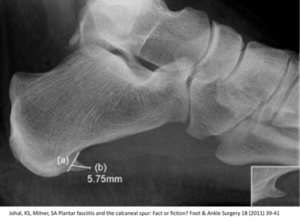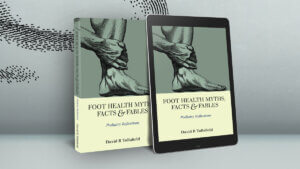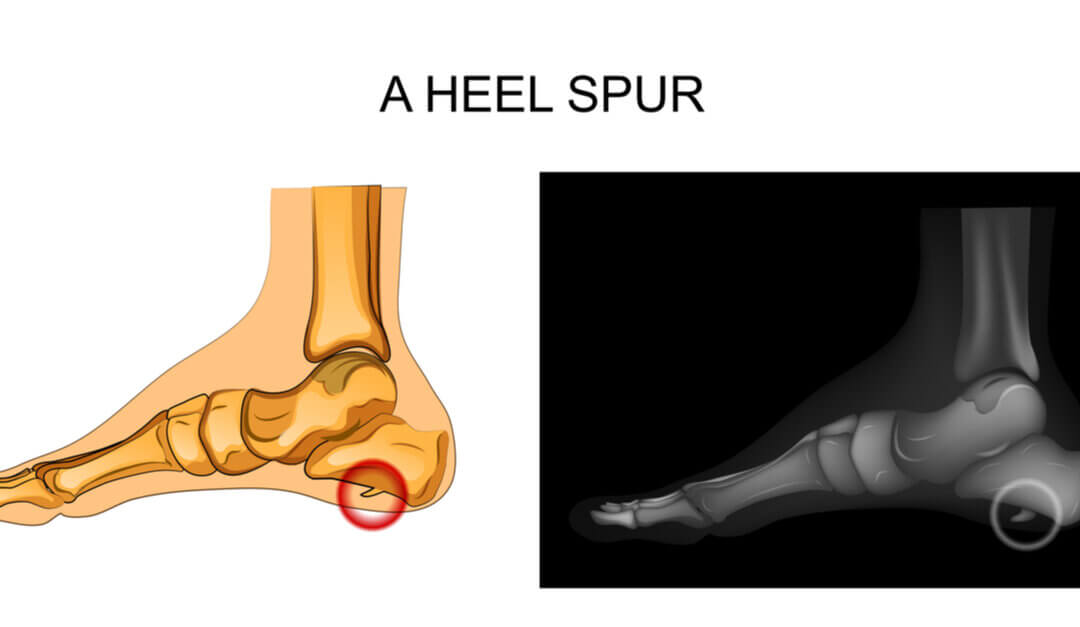The spur and plantar fasciitis
Nothing has been so maligned as the heel spur myth in the cause of heel pain. This is something no doubt many professionals dealing with MSK have to consider. To radiology professionals, it seems pretty clear, as indicated in this x-ray [1].

Johal et al 2012
Defining the spur
First of all, let us be clear. This is NOT a spur but a ledge of bone that goes all the way across the heel bone – calcaneus. The fascia band sits below the so-called spur and does not pull on the calcaneus (Johal et al, 2012). Johal looked at 22 patients with a diagnosis of PF[2] and relied on lateral x-rays alone. Cases were selected from Accident and Emergency with a diagnosis of ankle sprain rather than heel pain.
Features of growth
The fascial band shown in MRI scans confirm the co-association with fibres of the Tendo–Achilles (TA) but not with the bone causing a spur. This makes sense because, by 12 weeks of intrauterine life, the TA and fascia are as one and then diverge into two different planes. The main portion of the fascial band inserts into the medial tubercle, often associated with the greatest frequency of symptoms. Consider this; the separate body of the calcaneus arises around 6-8 years and joins the main body at 12-14 years. The gap is obvious in the juvenile, while the MRI shows incomplete ossification at this point. The figure illustrates the apophysis where the ledge or spur is in its’ primacy.
What other people are saying
“The body … attempts to repair itself by growing new bone in this area (a heel spur). Inflammation in the heel can even cause burning or shooting pain from nerve compression.” Michael DeBrulle (USA) posted this in 2009. This certainly was not an uncommon explanation.
“I have a heel spur” – this is something we commonly hear as a podiatrist. When it comes to plantar fasciitis (acute/short term) or plantar fasciopathy (chronic/long term), the evidence shows that pain is due to overuse of the plantar fascia, which is why pain is felt in the arch and heel. It is not always directly at the site of the spur. Heel spurs, also called calcaneal spurs or plantar spurs, develop as a response due to an inability of the plantar fascia to tolerate load. Our body can’t cope with what we are asking from it, and to protect the soft tissue, the bone grows! The overuse causes calcium deposits to form on the heel bone. The research shows that heel spurs are more commonly associated with heel pain. We blame a symptom (spur) rather than the culprit (expecting more from our feet than what their capacity is)! Melissa Zacharia (AU) 2019
As illustrated in the above samples, internet searches show up on many sites covering heel pain management. Opinions vary, but in most cases, clinicians try to tie up the concept of spur formation exclusively with stretching of the fascial band. While there may be truth in traction, this cannot account for the excess formation for most patients. The myth will always live on where clinicians cannot reach other explanations.
Surgery
Surgical intervention for spurs is an absolute no-no. Obviously abnormal bone growth not attributed to spurs will need specialist attention, but outgrowth malignancy is less common than malignancy within the body of the heel bone (calcaneus). You will read my patient journey report from a patient who did have a fascial band release and linked on this site when published. Surgery is performed as a minimal incision procedure and allows rapid mobility with few sutures. Reserved for difficult cases, this may apply to 5-10% from my own clinical case load. Most heel pain will settle with good conservative care.
You can read more about fasciitis on this website:

- Plantar Fasciitis and the foot arch
- Plantar Fasciitis and the Art of Stretching
- More Heel Problems Pain
- Heel Pain due to a bruised heel
Conclusion
You can have heel pain with a so-called spur, but it is just happenstance. Johal’s study is compelling, but the size of the cohort perhaps does not have the appropriate sampling. The use of CT scanning may be more appropriate to provide a 3D picture. If we go to Wikipedia, the story is slightly different. At the end of the day, the evidence that spurs cause pain is seen after taking x-rays of both feet. This author found over his 40-year career that the painful foot frequently had no spur, yet the fascial band’s thickness had increased. Painless feet are more frequently presented with spurs.
![]()
[1] Johal, KS, Milner SA 2012 Plantar Fasciitis and the calcaneal spur: Fact or fiction? Foot and Ankle Surgery 18;39-41
[2] PF or plantar fasciopathy is now considered fasciopathy or fasciosis
Thanks for reading ‘The heel spur myth’ by David R Tollafield
Sign-up for here my regular FREE newsfeed
Why not read Foot Health Myths Facts & Fables available from Amazon books

Published by Busypencilcase Communications Est. 2015 for ConsultingFootPain




Recent Comments